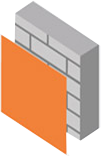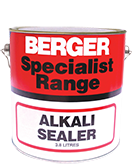Features
See allSurface preparation:
- Concrete and cement surfaces must be completely dry
- The sealer will NOT prevent blistering of top coats if moisture is present in the surface
- Once surface is dry, remove any peeling paint with a scraper and any white powder with a dry cloth
Application Procedure:
- Ensure that the concrete has been cured for at least 30 days
- Remove all efflorescence, other surface contaminants and loose material
- Wire brush (hand or power tool), dry abrasive blast or wash with high-pressure water jet
- Check moisture content of concrete with standard moisture meter
- Proceed if moisture content is <10%
- If >10% find and resolve moisture source before applying Alkali Sealer
Tips: Always remove efflorescence from surface before painting. Failure to do so will result in a poor, friable base, preventing sound adhesion of topcoats.
Tools you will need
Available Packs

1 Coat
10.0 m2/Ltr**
Coverage
On well-prepared surfaces, as per the painting system recommended. Please refer to the Product Data Sheet for surface preparation and method of application.
** Actual coverage may vary from the quoted coverage due to factors such as method and condition of application, surface roughness, and porosity.
Solve Potential Paint Problems
Chalking is the formation of a white, dusty powder on the paint film, and is actually a natural way for paint to breakdown as it weathers.
What are the possible causes?
- Long-term exposure of paint film to the elements
- Use of low-quality interior paint on an exterior surface
- Over thinning the paint
- Application of a thin paint film
- Failure to prime and seal the surface before applying topcoat
- Painting on a pre-existing chalky surface
What is the solution?
- Remove chalk residue using a stiff bristle or wire brush
- Wash with soap and water, and rinse thoroughly by hose or power washer
- Allow surface to dry and check for any remaining chalk by running a hand over the surface
- If noticeable chalk is still present, apply Berger Alkali Sealer or Berger Penetrating Liquid
- If no chalk is present, repaint as normal
- Repaint with a premium quality exterior coating
We recommend you use these painting systems in order of base coat, first coat, and second coat:
-
Get Inspiration
-
Make Your Plan

Let us design a project plan to suit your needs.
-
Colour Tools








-can_8696.png?width=82&height=102&mode=crop)


